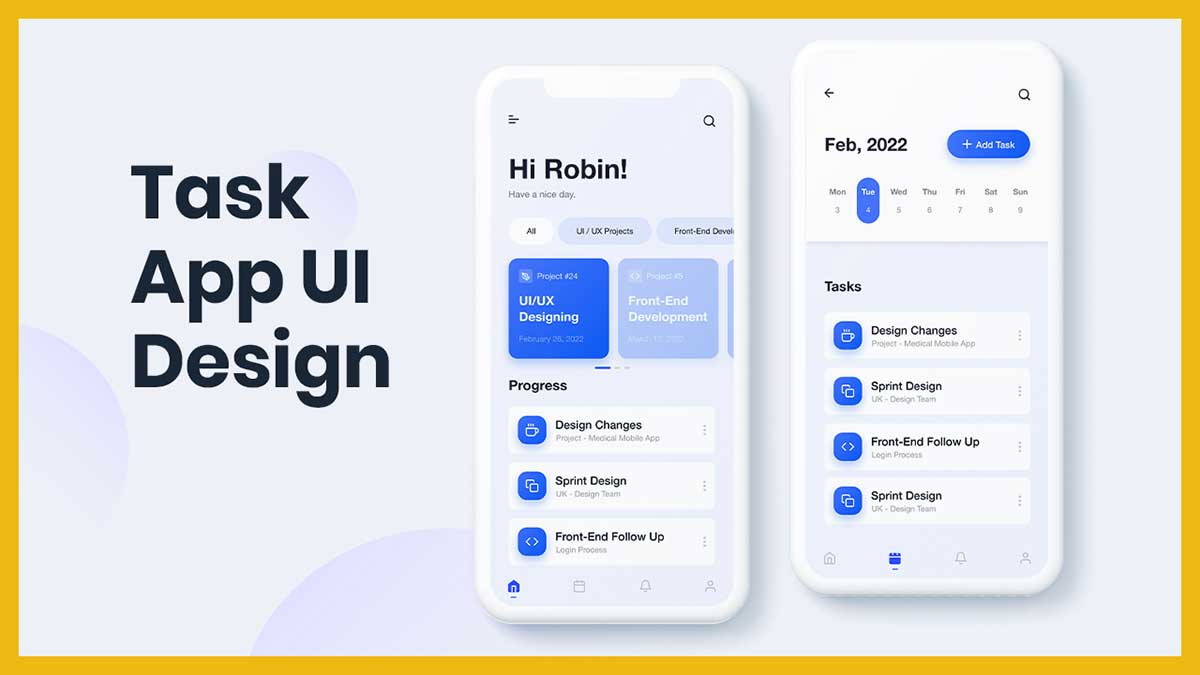Designing a Taxi Booking App UI/UX Design requires careful planning to ensure a smooth user experience. A well-structured UI allows users to easily request rides, select vehicles, and track their journey in real time. In this tutorial, we will create a taxi booking app UI with three mobile screens illustrating different stages of the ride-booking process. This guide is beginner-friendly and will help you understand essential UI/UX principles for ride-sharing applications.
Understanding the Ride-Booking Process
The Taxi Booking App UI/UX Design is divided into three essential screens:
- Location Selection (Ride Request Screen)
- Ride Selection Screen
- Ride Details Screen (Ride in Progress)
Each screen serves a unique purpose, and a seamless transition between them is crucial for a great user experience. Let’s go through each step with UI elements and best practices.
Screen 1: Location Selection (Ride Request)
Purpose:
This screen in taxi booking app UI/UX design allows users to set their pickup and destination locations, ensuring a straightforward ride-requesting process.
UI Elements:
1. Header Section:
- A visually appealing green background featuring a cityscape illustration and a yellow taxi.
2. Location Selection Box:
- Current Location Field: Displays the user’s current GPS location with an indicator (dot and line).
- Select Destination Field: Users can tap to enter their destination.
3. Saved Locations:
- List of frequently visited places for quick selection.
- Examples:
- Bakery Cafe – Washington Ave, 745
- Ocean Mall – Washington Ave, 745
- Each saved location includes a heart icon for favoriting locations.
Best Practices:
- Use auto-suggestion for destination input to enhance user convenience.
- Display recently searched locations to minimize typing efforts.
- Implement Google Maps API for precise location tracking.
Screen 2: Ride Selection
Purpose:
This screen lets users choose a vehicle type and confirm their booking in taxi booking app UI/UX design.
UI Elements:
1. Map Display:
- Shows the selected route from pickup to destination.
2. Vehicle Selection Section:
- Users can choose from different ride options. Each option displays:
- Price: (e.g., $150, $200, $250)
- Vehicle Type: Motorcycle, Hatchback, Sedan
- Estimated Arrival Time: (e.g., 35 min, 15 min, 10 min)
- The selected vehicle is highlighted with a yellow border.
3. Promo Code Field:
- Allows users to enter a discount code before confirming their ride.
4. Primary Action Button:
- A green “Let’s Go!” button for confirming the ride selection.
Best Practices:
- Provide estimated fare calculations to build trust.
- Offer ride options based on user preferences and past behavior.
- Highlight eco-friendly ride options for sustainability-conscious users.
Screen 3: Ride Details (Ride in Progress)
Purpose:
This screen provides real-time ride-tracking and driver details in taxi booking app UI/UX design.
UI Elements:
1. Map Display:
- A live route preview showing the driver’s location.
- A status notification: “Arriving in 45 minutes.”
2. Driver & Ride Details Section:
- Driver Name: “James Smith”
- Car Model: “Toyota Passo”
- Car Number: “BFA 267”
- Ride Type: “Standard”
- Driver Rating: 4.5 ★
3. Pickup & Drop-off Locations:
- Pickup: “St. James Area”
- Drop-off: “Gilbert #3 Bay Area”
4. Action Buttons:
- Call & Message Icons: Users can contact the driver.
- Cancel Ride Button: A black button allowing users to cancel the ride if needed.
Best Practices:
- Implement real-time tracking to keep users informed.
- Provide contact options for direct communication with the driver.
- Ensure clear visibility of pickup and drop-off details.
UI/UX Design Highlights
A great Taxi Booking App UI/UX Design should focus on simplicity, clarity, and ease of use. Here are the key takeaways:
1. Color Scheme & Visual Design:
- The app follows a green, yellow, black, and white theme, ensuring a fresh and modern look.
- Contrast elements make navigation intuitive and user-friendly.
2. Minimalist & Clean Layout:
- The UI avoids clutter, keeping only essential elements visible.
- Icons, typography, and white space improve readability.
3. Consistent Use of Icons & Buttons:
- Familiar icons enhance usability and make navigation effortless.
- Action buttons are prominent and visually distinct.
4. Real-Time Features & Functionality:
- Live tracking, fare estimates, and interactive maps create a seamless experience.
- Top-rated taxi booking apps for business travelers focus on reliability and efficiency.
5. User-Friendly Navigation:
- Affordable taxi booking app in Your City should provide intuitive navigation to attract more users.
- Easy-to-access ride details improve overall usability.
Case Studies of Successful Ride-Sharing App Designs
1. Uber & Lyft:
- Industry leaders with an emphasis on Best UI/UX practices for ride-sharing apps.
- Simple, yet powerful, UI that ensures fast ride booking.
2. Bolt & Ola:
- These apps have incorporated taxi booking app with real-time tracking for better accuracy.
- User-friendly designs focusing on driver ratings and estimated time of arrival.
3. Local Ride-Sharing Apps:
- Best taxi booking app for iPhone versions optimize interface for Apple’s ecosystem.
- Regional apps cater to user-specific needs by simplifying fare structures and localization.
Final Taughts
Creating an efficient Taxi Booking App UI/UX Design requires thoughtful planning and execution. By following this step-by-step guide, you can design a visually appealing and user-friendly ride-sharing app. Incorporate best practices such as real-time tracking, intuitive navigation, and minimalist design to enhance user experience.
Whether you’re designing the best taxi booking app for iPhone, an affordable taxi booking app in your city, or a taxi booking app with real-time tracking, focusing on UI/UX will set your application apart from competitors. Apply these insights to develop a top-rated taxi booking app that meets the needs of both riders and drivers.
To learn more about Figma UI/UX design Check out my YouTube channel (@uixDesignAcademy) for simple and easy beginner tutorials! and If you want to learn 100 days daily ui challenge here



